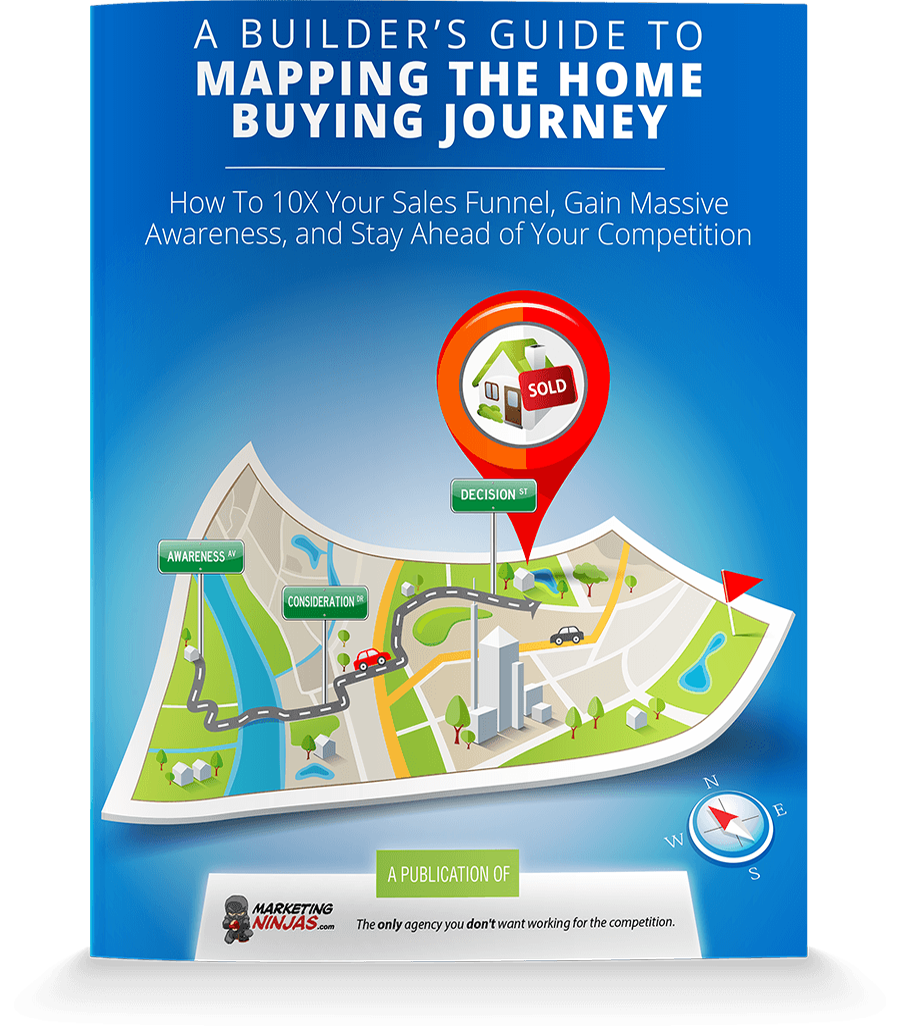Blogging Shmogging: Does Content Marketing Really Help You Sell Homes?
Blogging...
You know you should be doing it. You should have a company blog. It's a fundamental component to a solid content marketing strategy. Realistically, you don't have a content marketing plan without a blog.
You just aren't completely sure what all the hype is about.
Well, we've got the answers for you.
Reading time: 8 minutes
Level: Intermediate
Skip to the section you're most interested in:
It's been around for a while. There is some debate as to when it first came up, but most professionals recognize Links.net, founded by Justin Hall, as the first official blog back in 1994. However, in 1997, the term "weblog" was coined which came from Jorn Barger and his site, Robot Wisdom. And in 1998, Jonathan Dube was the first to use blogging on a traditional news site, when he talked about Hurricane Bonnie for The Charlotte Observer.
Great! What does that all mean for your home building business?
Business blogging is one of the top marketing tactics out there because it gets your business more visibility online. And that's what you need. To be as visible as possible.
A Serious Factor in Driving Traffic
Look, we get it. You want more traffic to your site. Who doesn't?!
So why not take advantage of one of the key ways to get said traffic? Yes, there are other ways to attract visitors to your site, but none are as easy or cheap as blogging. Paid ads? Nope, not cheap. And as soon as you stop paying, the traffic is gone. Email blast? Unless the contacts are ones you created and nurtured, don't even think about it. The crackdown on spam is just getting stronger - you do NOT want to find your company on the other side of a hefty fine simply because you bought an email list.
The three major players of driving website traffic are:
- search engines
- social media
- blogging
Look at it this way; your website is made up of individual pages. Usually, you don't have a lot of them. And let's be honest with ourselves, how often do you go in and update those pages? Yeah, it's not something 90% of companies do, go in and make adjustments to the Contact Us Page on the regular.
However, when you blog, you're continually adding new pages to your website. Pages that get indexed by search engines. More indexed pages = more chances to show up in a search result. In fact, websites that have blogs have 97% more inbound and indexed links. And that's just the start of the SEO benefits!
"SEO benefits?", you say? Yes, we do! Having more indexed pages tells search engines you have an active website, which is a good thing. This means those bots they send out to crawl and check sites will come to yours more often because they know you have new content on a consistent basis.
That covers point #1. Now, for #2...
All these wonderful and informative blog posts you're putting up are pieces of content your network can share on social media. Facebook, Instagram, Pinterest, LinkedIn - whatever strikes their fancy. This increases your exposure exponentially, and to a new audience. Someone clicks on a link and boom! Another site visitor! It's a wonderful thing.
Another great thing about business blogging is that your social media team can use it to help supplement their posting calendar. Rather than continually trying to come up with brand-new ideas for your social channels, they can supplement with your blog content. So it helps your team, increases the reach of your company, and helps to drive more visitors (aka traffic) to your site.
We mentioned social media is a key factor in traffic, and by keeping a consistent presence on social media, you're letting search engines know your site has something to offer. On top of that, those social posts can count as links to your site, increasing your authority ranking.
As for point #3, well... that's why you're reading this article, isn't it ;)
So let's get into the details!
 The Correlation Between Blogging and SEO
The Correlation Between Blogging and SEO
Above, we discussed blogging's SEO benefits on a higher level; let's go a little deeper.
Because each post you put up creates a new 'page' for your website, your blog becomes a collection of what search engines are looking for: content, keywords, and answers to the questions people are asking (well, as long as you're optimizing your blog posts).
It's pretty common knowledge that most users don't go past the first page of search results, which means it's pretty damn important to get on the first page. You get to that first page by using targeted keywords in your content (read: a blog post).
Look, SEO doesn't work without content. And the best place for content is on your blog.
In a Q&A interview, Google flat-out said the top three search ranking factors are:
- Content
- Links
- RankBrain
(If you have some time you can watch the video of the interview below, it's just over an hour).
Now, those first two? They don't work without the other. They aren't interchangeable, they are interrelated. You need content to have links, both inbound (other sites linking to you) and outbound (you linking to other sites).
Creating Content Searchers Want to Read
The most important factor in linking and content is QUALITY. No one wants to link to a bad site or have a bad site link to them. So when you're creating your content, "good enough", well, isn't. You have to make sure your content is well-thought-out and well-written.
- Well-thought-out: keyword research and planning. Gone are the days where you need to have one specific keyword for each page. Because of RankBrain, you can now combine similar keyword phrases into one piece, which encompasses the variety of options people can use to search for you, and RankBrain can 'read' it.
- Well-written: have you ever done a search, found an article you thought might answer your question and clicked on the link to find there are spelling and grammar mistakes in the first paragraph? Makes one cringe... that's just the basics of good writing. We recommend a professional writer. Just because someone can draft an email, doesn't make them a great writer, and you can't afford to cut corners when it comes to your content.
Content may be king, but if it's not of a high enough standard or doesn't answer the search query, searchers will bounce off your page and your rankings will drop. Fast.
 But What Should My Content Talk About?
But What Should My Content Talk About?
Ah, there's the big question, isn't it?
"What do I ask my team to write about?"
The thing is, you already have the answers to this question. When people are looking for home builders, what do they want to know?
- communities they can build a new home, and what kind of amenities are nearby
- mortgage and financial questions
- the buying and building processes
- home warranties
- model and floor plan options
- etc...
There are a TON of articles out there with common questions home buyers ask - start by answering those questions.
However...
Just because it's a question a home buyer might ask, doesn't mean you should have your team immediately draft up an article for your review. Focus on the questions your buyer personas will care about. For example, if you focus solely on custom home builds, it's not likely you have a first-time home buyer as part of your target market. You want your team to concentrate more on what a move-up buyer needs to know (there are differences!).
Another great resource to tap into is your sales representatives. Do they have a list of FAQ's they go through with almost all prospects? Great - there's more content you can write on! Your team can take that step further by also creating content that addresses common sales questions and objections like "building new costs too much" or "I have to sell my current house before I can buy" or "I don't know if I can qualify for a mortgage".
Remember how we talked about how your team can also use that content to supplement other marketing efforts? Your sales team can also use that content to help walk prospects through the buyer's journey. Picture it: the prospect asks about the details on your home warranty program. Your representative emails them a link to a blog post giving them the information, and they didn't have to wait three days for your rep to put it all together and write it out themselves.
You've Got Options
Guess what?
Not all content has to be written.
"Wait, what?" you say?
Let us explain.
Visual content has continued to grow over the last five years, and that trend isn't going anywhere. Take things like video, and infographics, for example. Brian Dean of Backlinko, arguably one of the world's foremost experts in SEO also talks about "embeddable images" which are another form of visual content.
The best part of visual content is it's highly shareable, which means others can embed your content (using you as a trusted authority) and if those sites are doing their SEO right, should link those embeds back to you.
By creating a blog post with visual content, you decrease the amount of actual writing your team needs to do and increase the likelihood of gaining more inbound links.
But you need to have a blog post to place that visual content on, and for people to link back to.
Another possibility? Create a video of a walk-through with a sales representative to go along with the post about your latest showhome. Your marketing team can post this on YouTube (with a link to the post in the video description), share it on Facebook (which links back to the post), and embed in the post itself. By sharing those videos on other platforms with a link back to the post, you're creating more inbound links.
It doesn't matter whether your company has been blogging for years and just aren't seeing results, or if your team is just dipping their toes into the blogging pool. If you keep the above ideas in mind when creating your content strategy, they'll help you make the most out of your home builder blog.







